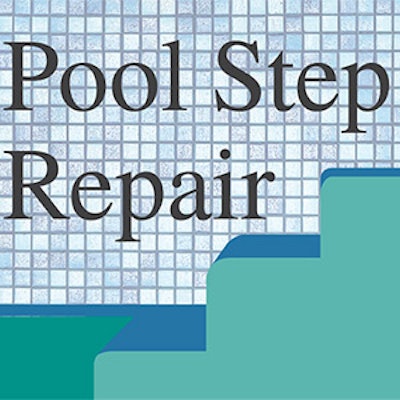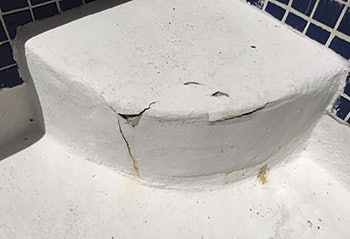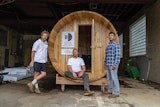
 The top step is more likely to fail than the other steps because it is typically exposed during the winter while other steps remain submerged, and protected, by water.
The top step is more likely to fail than the other steps because it is typically exposed during the winter while other steps remain submerged, and protected, by water.
A very common problem with concrete pools in cold northern climates is failure of the steps, most specifically the top step.
Why does the top step fail? This question has a surprisingly simple answer: It's often not finished correctly. In the harsh winter climate of the North, the top step experiences the worst possible conditions. Since northern swimming pools need to be winterized, and part of this process includes partially draining the pool, the top step of the pool is usually left exposed above the water level. (Water actually helps to protect the interior finish of a concrete pool during the winter.) Combine this with the more vulnerable horizontal surface of the top step and you are left with concrete susceptible to early failure.
During frigid sub-zero months, elsewhere in a winterized swimming pool, the submerged finish is shielded by water, and the vertical surfaces above the waterline are better oriented to resist freeze and thaw damage and delamination (due to different rates of expansion and contraction between the finish and the substrate). The top tread of the pool steps is not so lucky.
RELATED: Concrete, Heal Thyself!
So is the answer to top up a concrete pool after winterizing it? Not necessarily. That would be like taking an aspirin because you have a rock in your shoe. Sure, it will help, but why not address the problem specifically? The top step of a concrete pool in a cold climate location should not be plaster or painted — it should be tiled.
 A tiled step adds more than just beauty and elegance to the pool. Properly installed with a layer of waterproofing, it provides durable protection for the concrete underneath.
A tiled step adds more than just beauty and elegance to the pool. Properly installed with a layer of waterproofing, it provides durable protection for the concrete underneath.
TILING THE TOP STEP OF THE POOL
For concrete pools in regions with harsh winter temperatures, the top step should be tiled for protection and aesthetics. If you want to keep the look consistent, you can tile the horizontal surfaces of all the step treads, but at minimum you should have the top step tiled with a commercial grade, matte (non slip) tile. Porcelain tiles are much, much stronger than ceramic tiles, and you should look for a freeze-rated tile specifically for this application.
For tile to be freeze-resistant, it needs to be installed in a very specific way that includes using a waterproofing layer from a quality manufacturer. A roll-on membrane substrate treatment will create a waterproof layer that is suitable for tile installation. Could you just use regular modified thinset? You could, but it will fail early compared to well-set tile with a proper waterproof layer.
Regular thinset products are porous, as is the concrete shell of your pool. That means if you set tile on your pool step, water will still be able to leach into the shell of the pool through the tile grout joints. While tile that is set without a waterproof membrane may still last quite a few years before failing, taking the time to use a waterproof layer before setting the tile means you will probably never need to revisit this issue.
And remember, the top step of a concrete pool in a cold climate application is the holy grail for tile endurance, so using the right products for the job is essential. Don't skimp or cut corners here.
PREPARE FOR TILE
Before you start thinking about tiling the step, remember: The new tile installation is only as good as the substrate you are bonding to. If you are working on an older concrete pool, or a top step that already shows signs of deterioration, you will need to take a few steps back before you can move forward.
RELATED: Case Study: Repairing Structural Cracks
First remove any loose or compromised concrete on the step treads. Compromised concrete can be a little tricky to spot if you don't know what you are looking for. Basically, as concrete ages it becomes less and less water resistant. As water passes through the concrete, the cement within dissolves and travels with the water, leaving the aggregate component behind. Without the cement "glue" to hold all the aggregates together, the strength of the concrete is reduced. If the steps in the pool feel weak, or if you can poke and scrape them with a screwdriver and remove small chunks of sandy concrete, you need to remove some of this concrete before proceeding to install tile.
In some cases the concrete will be thoroughly compromised and you will need to chip (jackhammer) a few inches of concrete out of the top step and pour new concrete in its place before you can begin applying the waterproof membrane layer. (If you're taking this step, make sure to brush up on bonding new concrete to old concrete.) But in most cases, the concrete of your top step will just need some remediation, not jackhammering and replacement with new concrete, and a diamond cup wheel on an angle grinder will render a perfect (and level) surface to begin your membrane and tile setting.
Note: A diamond cup wheel attached to an angle grinder is a dangerous, high-rpm tool, and should be used with great care and a strong, confident hand. If you want a little more control, consider using a variable-speed grinder.
Proceed to grind down the top step, leaving the surface as flat and level as possible. Usually you will not need to go deeper than 1/8 or 1/4 inch with the cup grinder before you expose substrate suitable for building on. The diamond cup is not suitable for removing an inch or more of concrete from the step — if you need to remove that much concrete, use a chipping hammer and re-pour the step with concrete before proceeding with the tiling steps outlined in this article.
CAN TILED STEPS ALSO FAIL?
While much more resilient than a mortar-based surface, tiled steps, over time, can still fail due to improper or inadequate installation as well as harsh freeze-and-thaw conditions. If your tiles are frost-rated, and preferably porcelain, there is little chance the tiles themselves will crack; it is more likely water will be able to get underneath the tiles and into the substrate, which will almost certainly result in at least a few popping off.
Once water gets under tiles, it can freeze and cause a mechanical separation in the thinset (or mud base layer). Winter ice can also "grab" the tiles if the water is both under and on top of the tile itself. As the ice in the pool migrates even to the smallest degree, the tiles will have no choice but to pull off with the force of the moving ice.
RELATED: Winterizing Revisited
This is why it's crucial to protect your tile installations with a waterproof membrane layer that will prevent water from getting under the tile and protect the tile against shifting or cracking substrate conditions.
Steve Goodale is a second generation swimming pool expert located in Ontario, Canada. You can learn more about Steve, as well as swimming pool construction, maintenance and the lighter side of the industry at his website: SwimmingPoolSteve.com.












































